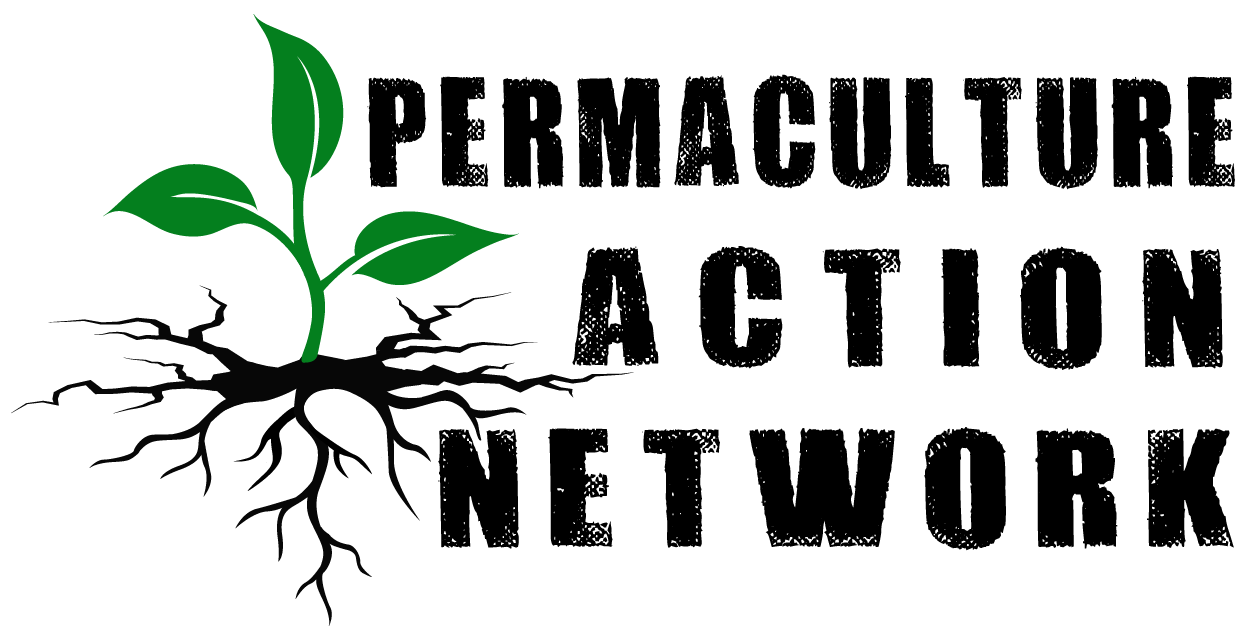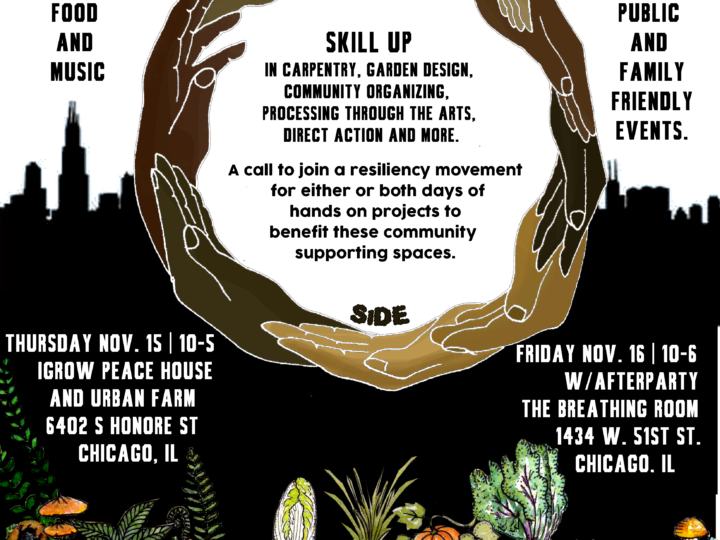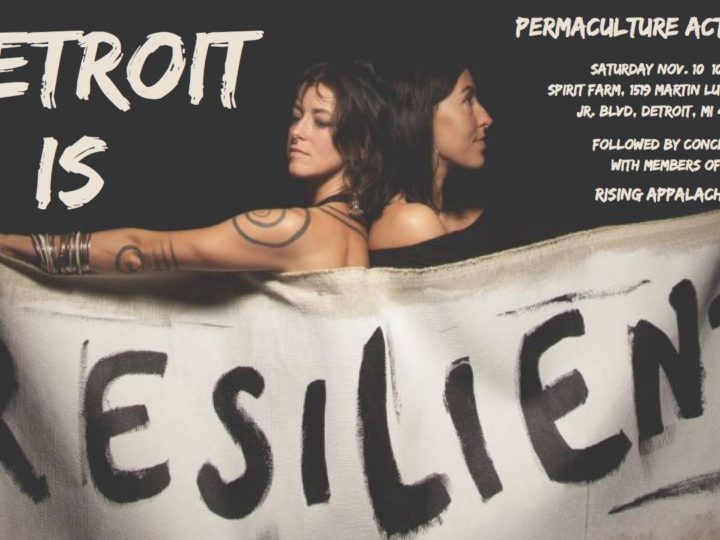Establishing a Local Food Supply….With No Water:
Year 4 of SONIC BLOOM Permaculture Action Day at District ONE Farms
On Thursday, June 14th, seventy people on their way to the annual Sonic Bloom Festival at Hummingbird Ranch mobilized to take action at District One Farms in Walsenburg, CO. The festival has worked with Permaculture Action Network for the last four years to outreach to its attendees and invite them to a day of direct action in the local community.

District ONE Farms is one of the most ecologically regenerative and economically revolutionizing projects Permaculture Action Network has worked with, in concept. These two community farms, one at the John Mall High School and the other at Fiesta Park in Walsenburg, CO, grow food for a farm-to-table, pay-what-you-can restaurant located along the downtown strip of the city. At the John Mall High School location, where a high school culinary class gets to become familiar with the process of growing as well as preparing their own food, the farm isn’t allowed to use the municipal water for irrigation. These limitations have driven the District ONE farmers, and the Permaculture Action Day organizers and facilitators, to find creative solutions.
This is where we start. It doesn’t look like much, but this is actually a significant improvement to the land’s plant diversity, soil health, and water storage. You’re looking at a “swale.” It’s essentially a ditch dug into the soil surface along a line made by connecting equal points of elevation. It has a mound on the downslope side that stops water from flowing downhill. The ditch directs water into the soil itself, rather than allowing it to wash down the slope to the lowest point of elevation. You can make out the ditch in the soil that was dug three years ago if you look closely. See how the plant life in the foreground along that swale is much more green, flowery, tall, and vibrant than the plant life in the background? That’s the effect, over time, of catching rainwater in the soil with earthworks.

This is where we start. It doesn’t look like much, but this is actually a significant improvement to the land’s plant diversity, soil health, and water storage. You’re looking at a “swale.” It’s essentially a ditch dug into the soil surface along a line made by connecting equal points of elevation. It has a mound on the downslope side that stops water from flowing down hill. The ditch itself directs water into the soil itself rather than allowing it to wash downhill. You can make out the ditch in the soil that was dug three years ago if you look closely. See how the plant life in the foreground along that swale is much greener, flowery, tall, and vibrant than the plant life in the background? That’s the effect, over time, of catching rainwater in the soil with earthworks.

This year we planted edible perennials—food producing plants that live for multiple years continuously—and other beneficial perennial plants into the rainwater catching swales; among them Black Locust, Pea Shrub, Buffaloberry, Serviceberry, and Comfrey. We then mulched the plantings heavily to make sure the moisture in the soil around the plants is protected from the evaporation of the hot sun during the day. Many of the plants came from Vanessa Harmony’s nursery at the Central Rocky Mountain Permaculture Institute.
This year we planted edible perennials—food producing plants that live for multiple years continuously—and other beneficial perennial plants into the rainwater catching swales; among them Black Locust, Pea Shrub, Buffaloberry, Serviceberry, and Comfrey. We then mulched the plantings heavily to make sure the moisture in the soil around the plants is protected from evaporation by the hot sun during the day. Many of the plants came from Vanessa Harmony’s nursery at the Central Rocky Mountain Permaculture Institute.
Because of the difficulty of growing plants in this climate with such limited water, the District ONE Farmers are turning to growing in greenhouses as well. Brian and Brock, two of the lead farmers, rebuilt a greenhouse on the site earlier in the year. During the action day, we built a retaining wall on the north side of the greenhouse with used tires. Leaving the glass south wall of the greenhouse unobscured as possible lets in maximum sun, and insulating the north wall retains heat so that even tomatoes can be grown into the winter.


Because of the difficulty of growing plants in this climate with such limited water, the District ONE Farmers are turning to growing in greenhouses as well. Brian and Brock, two of the lead farmers, rebuilt a greenhouse on the site earlier in the year. During the action day, we built a retaining wall on the north side of the greenhouse with used tires. Leaving the glass south wall of the greenhouse unobscured as possible lets in maximum sun, and insulating the north wall retains heat so that even tomatoes can be grown into the winter.

The earthen tires are them tamped into place, creating a thick insulating wall. Pounding earth into tires is a great way to get down to some loud rhythms coming from the sound system.
The earthen tires are them tamped into place, creating a thick insulating wall with compacted dirt. Pounding earth into tires is a great way to get down to some loud rhythms coming from the sound system.

On a hot, sunny, and windy day like June 14th, 2018, a sound system with some well-curated selections and original music keeps the people going. We were just reminded of this the prior month when David Satori of Beats Antique played a surprise set at the Summer Camp Music Festival Permaculture Action Day in Illinois. At SONIC BLOOM’s action day, hip hop artist Mike Wird, Ableton-producer Ja Ja, live electronic producer Sonic Warrior Music, and Tryptamix—who played an all original, mostly unreleased set—kept the rhythm.

On a hot, sunny, and windy day like June 14th, 2018, a sound system with some well-curated selections and original music keeps the people going. We were just reminded of this the prior month when David Satori of Beats Antique played a surprise set at the Summer Camp Music Festival Permaculture Action Day in Illinois. At SONIC BLOOM’s action day, hip hop artist Mike Wird, Ableton-producer Ja Ja, live electronic producer Sonic Warrior Music, and Tryptamix—who played an all original, mostly unreleased set, kept the rhythm.

Michael Alcazar, an indigenous permaculture designer and youth educator living in Denver, opened the action day with a call to spirit to assist everyone participating in the action day to revitalize the land. The ceremony that followed offered a plate of the action day’s shared meal—couscous and roasted vegetables, a green salad, and watermelon—to the ancestors, and opened the circle for an orientation and welcome.
Michael Alcazar, an indigenous permaculture designer and youth educator living in Denver, opened the action day with a call to spirit that everyone participating in the action day be assisted in revitalizing the land. The ceremony that followed offered a plate of the action day’s shared meal—couscous and roasted vegetables, a green salad, and watermelon—to the ancestors, and opened the circle for an orientation and welcome.
A chicken tractor build was facilitated by Everarde Calk of Yogardener, a Permaculture Action Network organizer starting a new BioRegional Crew in Atlanta. Chicken tractors are mobile chicken coops that can be moved around a farm from spot to spot. This allows the chickens to eat weeds and insects, and for the chickens to scratch the soil and add manure. Chickens get nutrients; the farm benefits from reduced weeds and insects that eat crops, and the soil benefits from a micro-tilling and the addition of organic fertilizer.

A chicken tractor build was facilitated by Everarde Calk of Yogardener, a Permaculture Action Network organizer starting a new BioRegional Crew in Atlanta. Chicken tractors are mobile chicken coops that can be moved around a farm from spot to spot. This allows the chickens to eat weeds and insects, and for the chickens to scratch the soil and add manure. Chickens get nutrients; the farm benefits from reduced weeds and insects that eat crops, and the soil benefits from a micro-tilling and the addition of organic fertilizer.

Inside the greenhouse, a wicking bed was built to grow annual vegetables and greens. The wicking bed functions by storing water in the sealed bottom of the bed container, along with gravel. The water can then “wick” up through the soil in the same way water travels up a paper towel when you dip just the bottom corner of it in a glass of water. This allows plants to stay irrigated “from the bottom up” without a person having to water them every day. Instead, the wicking bed can be filled every 2-4 weeks through a plastic pipe in the corner of the bed that empties into its bottom.
Inside the greenhouse, a wicking bed was built to grow annual vegetables and greens. The wicking bed functions by storing water in the sealed bottom of the bed container, along with gravel. The water can then “wick” up through the soil in the same way water travels up a paper towel when you dip just the bottom corner of it in a glass of water. This allows plants to stay irrigated “from the bottom up” without a person having to water them every day. Instead, the wicking bed can be filled every 2-4 weeks through a plastic pipe in the corner of the bed that empties into its bottom.
Accompanying the wicking bed is a “barrelponics” system, a play on the aquaponics food growing systems that are becoming more popular amongst urban farmers. The barrelponics systems was built from this simple design drawn by one of our action day facilitators. Check out this PDF for a concept of how the system works.

Accompanying the wicking bed is a “barrelponics” system, a play on the aquaponics food growing systems that are becoming more popular amongst urban farmers. The barrelponics systems were built from this simple design drawn by one of our action day facilitators.
Projects volunteers could participate throughout the day in a myriad of hands-on projects:
Planting Trees & Perennial Guilds on the Swales;
Planting Herbs & Flowers;
Mushroom Inoculation;
Building Compost &
Resource Bins;
Applying Compost Tea;
Building a Tire Foundation for the Greenhouse;
Installing Insulation & Water Barrels in the Greenhouse;
Constructing Barrelponics System;
Building Wicking Beds for the Greenhouse;
Painting Rain Barrels & Signs


From water-saving growing beds in the greenhouse to improvements on the swales and rainwater catchment earthworks, this action day made huge steps in bringing this dry, sun-scorched community farm to a food-producing, water retaining ecosystem. Permaculture teaches us that the system has to be understood as a whole composed of interconnected elements. The roots of the perennial edible plants in the swales benefit from the retention of water while facilitating the water’s movement deeper into the ground. The chickens builds the soil, helping it to retain more moisture. Small trees and shrubs will soon shade the area, protecting from the sun’s evaporation. Whole communities of microbes benefit from these processes, and in turn benefit the plants they feed. The water-smart systems in the greenhouse nurture annual produce immediately useful in the farm-to-table, pay-what-you-can restaurant downtown. The resource bins hold useful mulch materials like straw, wood chips, and cardboard on site. All this and more contribute to the resilience, diversity, and productivity of the system, and the human community that inhabits it.





Written by: Ryan Rising
Photos by: Zac Fabian & Caito Foster
Video by: Zac Fabian






